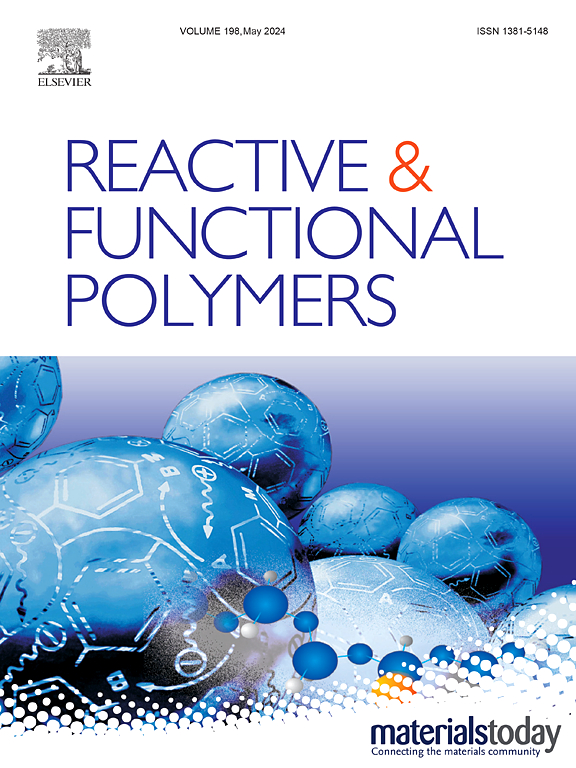用于软离子电子学的高灵敏度和可拉伸的无液体离子导电弹性体
IF 5.1
3区 工程技术
Q1 CHEMISTRY, APPLIED
引用次数: 0
摘要
软离子导体对于开发可拉伸、透明的离子电子器件(如离子皮肤、人机界面和软发光器件)至关重要。然而,基于水凝胶和离子凝胶的传统离子导体由于其液体成分的固有局限性(如冻结、蒸发和泄漏)而面临挑战,这限制了它们在各种复杂环境中的使用。在这项研究中,我们通过将二(三氟甲烷磺酰)亚胺锂(LiTFSI)与乙二醇甲基醚丙烯酸酯(MEA)和丙烯酸丁酯(BA)共混物整合,然后光诱导共聚来克服这些障碍,合成了一种无液体离子导电弹性体(ICE)。在0 - 200%的应变范围内,其拉伸性能可达754%,杨氏模量可达1.18 MPa,电导率可达1.6 × 10−2 S m−1,灵敏度(测量因子)可达2.51。重要的是,不含液体成分显著提高了基于ICE的器件的耐用性和寿命,从而解决了传统离子导体的缺点。我们还开发了几种基于ice的传感器,这些传感器具有高测量因子,可以检测人体运动,如手指弯曲或肘部旋转。此外,3 × 3传感器阵列在准确识别触摸压力位置方面表现出卓越的性能,突出了ICE在先进软电子设备设计中的潜力。本文章由计算机程序翻译,如有差异,请以英文原文为准。

Highly sensitive and stretchable liquid-free ionic conductive elastomers for soft Ionotronics
Soft ionic conductors are essential for developing stretchable, transparent ionotronic devices such as ionic skins, human-machine interfaces, and soft luminescent devices. However, traditional ionic conductors based on hydrogels and ionogels face challenges due to the inherent limitations of their liquid components, such as freezing, evaporation, and leakage, which restrict their use in varied and complex environments. In this study, we synthesized a liquid-free ionic conductive elastomer (ICE) by integrating lithium bis(trifluoromethanesulfonyl)imide (LiTFSI) with an ethylene glycol methyl ether acrylate (MEA) and butyl acrylate (BA) blend followed by photoinduced copolymerization to overcome these obstacles. The ICEs exhibited excellent electro-mechanical characteristics, including remarkable stretchability up to 754 %, Young's modulus up to 1.18 MPa, conductivity up to 1.6 × 10−2 S m−1 and sensitivity (gauge factor) up to 2.51 within 0–200 % strain. Importantly, the absence of liquid components significantly enhanced the durability and lifespan of the device based on the ICE, thus addressing the drawbacks of traditional ionic conductors. We have also developed several ICE-based sensors with high gauge factors to detect human body movements like finger bending or elbow rotation. Moreover, a 3 × 3 sensor array demonstrates exceptional performance in accurately identifying the locations of touch pressure, highlighting the potential of ICE for the design of advanced soft electronic devices.
求助全文
通过发布文献求助,成功后即可免费获取论文全文。
去求助
来源期刊

Reactive & Functional Polymers
工程技术-高分子科学
CiteScore
8.90
自引率
5.90%
发文量
259
审稿时长
27 days
期刊介绍:
Reactive & Functional Polymers provides a forum to disseminate original ideas, concepts and developments in the science and technology of polymers with functional groups, which impart specific chemical reactivity or physical, chemical, structural, biological, and pharmacological functionality. The scope covers organic polymers, acting for instance as reagents, catalysts, templates, ion-exchangers, selective sorbents, chelating or antimicrobial agents, drug carriers, sensors, membranes, and hydrogels. This also includes reactive cross-linkable prepolymers and high-performance thermosetting polymers, natural or degradable polymers, conducting polymers, and porous polymers.
Original research articles must contain thorough molecular and material characterization data on synthesis of the above polymers in combination with their applications. Applications include but are not limited to catalysis, water or effluent treatment, separations and recovery, electronics and information storage, energy conversion, encapsulation, or adhesion.
 求助内容:
求助内容: 应助结果提醒方式:
应助结果提醒方式:


